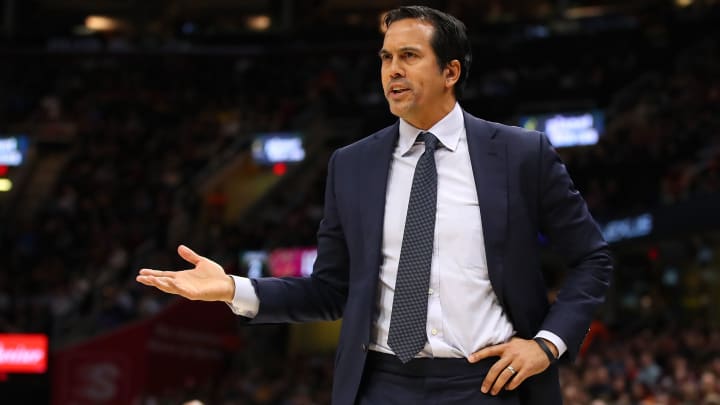The Case for Erik Spoelstra as Coach of the Year

Take a glance at an NBA sideline. On most nights, there’s plenty of shot creators, playmakers and specialists at a coach’s disposal. Playoff contenders like Brad Stevens’s Celtics, Mike D’Antoni’s Rockets or Dwane Casey’s Raptors are flush with talent granting unparalleled flexibility to execute sorcery-level moderations of the pick-and-roll or dribble-handoffs.
Then there’s Erik Spoelstra. For the second straight year, the Miami Heat coach is refining the sketches of his basketball coaching oeuvre. Where the cavalcade of superstars and offense is the norm, Miami is an anomaly. The Heat are one of the worst teams in the league when it comes to producing points. Still, this roster of veteran castaways and unproven youth occupy the fourth seed in the Eastern Conference playoff race. Kudos to the clipboard wizardry of Spoelstra who’s transformed a lackluster 15–15 start into a 28–21 turnabout.
But how?
Typically winning in the NBA is moored to the shoulders of superstars and Spoelstra, through no fault of his own, has deviated from the status quo. Miami’s top four scorers on the season have collectively missed 50 games; Dion Waiters (out for the season), Hassan Whiteside (18 games), Goran Dragic (5 games) and Tyler Johnson (4 games).
How the NBA’s New Two-Way Contracts Helped Reshape the Clippers
Roster turnover can be an impediment to success, and no NBA coach has been better at adjusting to injuries and maximizing more with less than Spoelstra.
Comparable to the team’s 30–11 run in the second half of last season, this year the Heat are fielding a top 10 defensive unit behind discipline and hustle. While they aren’t defensively stout at every turn, Miami emerges in the diminutive statistics absent from the conventional box score.
When it comes to shots at the rim, the Heat are third in the league at defending shots under 10 feet and also fourh-best at contesting within six feet of the basket. That doesn’t mean Miami gets lazy further out as they contend 63.8% of opponent field goals, good for fifth in the NBA.
Any casual spectator can look at the Heat and point out their lack of an elite defender. Spoelstra masks this small flaw by getting his group to outwork teams in scrabbles for loose balls. Without any defensive stalwarts, Miami manages to recover 8.5 loose balls per game, ranking inside the NBA’s top 5 in that category.

Spoelstra’s offensive sets and play calling are equally impressive, generating points for this offensively adverse roster. With Waiters out for the season, Spoelstra lost his most aggressive one-on-one scorer. In addition, Whiteside has seen his role reduced as he’s struggled at times adjusting on both ends of the floor in late game situations.
Spoelstra is diving into his bag of tricks by maximizing player skill sets to get offensive output. A perfect example is his experiment with James Johnson as a secondary ball handler. Johnson is averaging a career-best 4.0 assists per game, eclipsing his previous high of 3.6 last season. The veteran’s role and minutes increased this season, as Spoelstra decided to call on him to run the offense at various points each night.
The versatility and unselfishness of Johnson allows Spoelstra to use a variation of screens and cuts to free up guys off the ball. Johnson utilizes his IQ by either finding a crevice in the defense to score on his own or pinpointing a lead pass for an easy bucket.
While Spoelstra can take advantage of Johnson’s strengths, he’s also wise not to lean on him to score points. It’s not an easy task. Instead, he uses other methods such as dribble-handoffs to find easy looks at the basket.
Even As His Wizards Flatline, Bradley Beal's Star Rises
In theory, most teams run the dribble handoff as a chink in their system, but few live by it the way the Heat do. Miami is second in the NBA in handoff possessions. Within that same category, the Heat only trail the Detroit Pistons in field goals made and attempted out of it.
Spoelstra’s use of multiple ball handlers in dribble-handoff situations, coupled with the addition of cutting bodies, gives the offense various options to score without the presence of an elite scorer. While seemingly unorthodox, it's served as a dynamic method for the Heat to pull out wins up to this point, and more reason why Spoelstra’s work is deserving of high-level recognition.
For Miami to make serious noise in the playoffs, it would require star-level talent—something that they don’t possess and more than likely won’t acquire as the trade deadline looms ahead.
But the approach of Spoelstra designing his system to fit the mold of players dispatched on the court warrants his candidacy as the leading Coach of the Year candidate. An award that has been elusive to him throughout his career.
Despite four straight Finals appearances and two championships in the Big Three Era, Spoelstra was hardly, if ever, on the receiving end of acclaim for such feats. He was more often seen as little more than a game manager who was lucky enough for three franchise players to choose Miami at the convincing of Pat Riley.
Still, in the wake of LeBron James, Chris Bosh and Dwyane Wade’s departure, Spoelstra has the Heat on the verge of their eighth playoff berth in 10 seasons at the helm—a testament to his ability to put his players in optimum positions for success.
If the masses inspect how one of the league’s unheralded coaches turned this Heat team into a playoff adversary, it’s sure to finally bring recognition.
